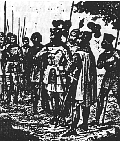
I have played DBR three or four times and read through the rules several times. DBR is clearly a derivative of DBM. Their are many changes which are briefly described in this article Some are intended to reflect the flavor of the period, some are system improvements which could be readily applied to DBM as well.
 This is still a game of Rock- Paper- Scissors, but now there are new troop types to learn to manage plus the rule changes. With this limited experience, it still appears to be a game of getting the right matchups. Here are some of the obvious changes with a little editorial comment thrown in. A thorough discussion of tactics and new troop types is a subject for another article.
This is still a game of Rock- Paper- Scissors, but now there are new troop types to learn to manage plus the rule changes. With this limited experience, it still appears to be a game of getting the right matchups. Here are some of the obvious changes with a little editorial comment thrown in. A thorough discussion of tactics and new troop types is a subject for another article.
The most obvious change is the different combat values for each troop type, there have been minor changes from DBM to support the flavor of the period. The combat results table is also changed, mostly for the better. Light Horse is no longer invincible and is killed on a double. A new innovation is that some kills on a simple majority only occur if the die roll was odd ( not 100% of the time) Also, there are more cases where kills on simple majority occur only in the enemy's bound. It pays to attack. A significant improvement is that the kill zone behind a unit is now a base depth, not a base width.
All of the units are now regulars, they cost more but do not have the movement problems of DBM irregulars (this is disappointing to me!) Some troops are required to follow up after a victory, but there is no impetuosity.
Allies are no longer unreliable (hallelujah) and the Army breakpoint is now based on the two largest commands breaking rather than 50% of the total unit count. On a related note, there are no troop types which count as only half stands for breakpoint purposes. It pays to buy some hordes and skirmishers.
PIP System Changes
Perhaps the most important changes related to the period (other than the troop types) is the PIP system. It now costs 3 PIPs to move a group wider than 4 stands Smaller groups and individual units still cost one. There is a great incentive to move about in battalions that are 4 stands wide rather than in the wide lines needed in DBM. All generals now get the free PIP bonus once per bound, not just the CinC.
Movement is further impacted by some other minor changes. The scale is bigger: 50 paces is now a base width i.e. 40 mm; in DBM 50 paces is 25.4 mm. Distance is covered more quickly. Marches must now end at 300 paces rather 200 paces. There is more time for ranged fire. There are no off table flank marches.
In the miscellaneous category, there are provisions for rallying beaten troops. Artillery has nearly unlimited range on the table, but must still shoot at the nearest target. Terrain placement has been modified slightly, the table now has four quadrants rather than 6, and there are only 5 placements by the defender, two of which may be adjusted by the attacker. The attacker gets to choose his direction of approach with no chance of failure.
This is a quick look at many of the obvious changes. A detailed analysis of how it all plays still needs to be accomplished, perhaps in a future writing. DBR certainly has potential.
Back to Saga #53 Table of Contents
© Copyright 1996 by Terry Gore
This article appears in MagWeb (Magazine Web) on the Internet World Wide Web.
Other military history articles and gaming articles are available at http://www.magweb.com
